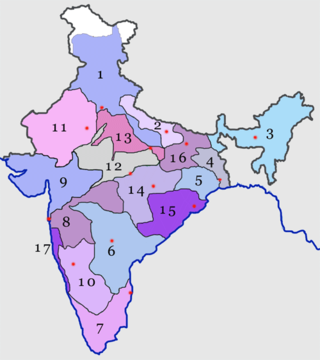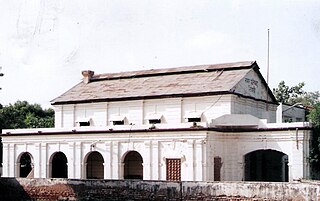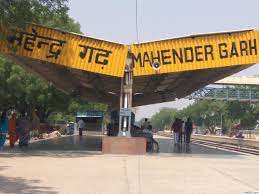
The North Western Railway is one of 19 railway zones in India. It is headquartered at Jaipur, Rajasthan and has 59,075+ employees, 658+ stations and a route length of more than 5,761 kilometres (3,580 mi) across the states of Rajasthan, Gujarat, Punjab and Haryana. NWR operates international rail service Thar Express from Jodhpur to Karachi. This zone is the key enabler of the Delhi–Mumbai Industrial Corridor Project by virtue of running railways 1,500 km long Western Dedicated Freight Corridor.

The Northern Railway (NR) is one of the 19 Railway zones of India and the northernmost zone of the Indian Railways. It is headquartered at Baroda House in New Delhi.

Rewari is a city and a municipal council in Rewari district in the Indian state of Haryana. It is district headquarter of Rewari district. It is located in south-west Haryana around 82 km from Delhi and 51 km from Gurgaon. It lies in Ahirwal region.

The Bombay, Baroda and Central India Railway was a company incorporated in 1855 to undertake the task of constructing railway lines between Bombay to the erstwhile Baroda State, that became the present-day Baroda (Vadodara) city in western India. BB&CI completed the work in 1864. The first suburban railway in India was started by BB&CI, operating between Virar and Bombay Backbay station, a railway station in Bombay Backbay in April 1867.

Delhi Sarai Rohilla railway station is situated about 4 kilometres from old Delhi railway junction in India. It is managed by Delhi Division of Northern Railway zone. Many trains from Delhi to Haryana, Punjab, Rajasthan and Gujarat stop at this station. More than twenty trains including Duronto and AC trains originate at this station.
Karoli is a village located in Kosli Tehsil, Rewari District, Haryana, India. It is on the 1.5-kilometre approach road boarded to Bahu-Jholri on the Kosli–Kanina road and is 12 kilometres from Kosli and 7 kilometres from Kanina. The villages is 125 kilometres from Delhi, the capital of India. It is a large village with an approximate population of 5,000 to 5,500. There is an average of one person in the army from each family. Smt. Kamala Devi is second ladies sarpanch of the village after Smt. Bhoori Devi. There are numerous temples in the village, of which that of Baba Thakur Ji and Baba Lal Das Hanuman Mandir has a special importance. All the villagers used to have dinner in the temple on Holi. The village school was earlier up to class 10 and due to excellent results in the entire district, the school has been upgraded to Senior Secondary School. The village was the birthplace of Hari Ram Arya, the Chairman of Haryana Azad Hind Fouj who participated in the Indian Independence Movement.
Kotia is a village located in Kanina tehsil, district Mahendragarh, Haryana state of India. It is on the Kosli–Kanina road and is 17 kilometres from Kosli and 3 kilometres from Kanina.
Bawwa is a village in the Nahar Block of the Rewari District in Haryana, India. It is located 50 kilometres (31 mi) northwest of the district headquarters of Rewari, 10 kilometres (6.2 mi) west-southwest of Nahar, and 320 kilometres (200 mi) from the state capital Chandigarh. Karoli, Garhs, Sihor, Bahala, Naya-Gaon, and Gadhi are the neighboring villages. Bawwa is situated approximately 3 km from Karoli mod on Kanina-Bahu-Jholri road in the Rewari District.
The Western Dedicated Freight Corridor or Western DFC is a 1,506 km long, under-construction 1,676 mm freight corridor in India. It will connect Dadri in Uttar Pradesh with Jawaharlal Nehru Port in Navi Mumbai, Maharashtra. The corridor is being built by the Dedicated Freight Corridor Corporation of India Limited (DFCCIL), a public-sector unit (PSU) under the Ministry of Railways and would be electrified with double-line operation. The Western DFC entails a new single-line branch from Prithla in Palwal district to Tughlakabad in Delhi, running parallel to the existing New Delhi–Faridabad–Palwal railway line.

The Delhi–Fazilka line is a railway line connecting Delhi and Fazilka the latter in the Indian state of Punjab. There is a link to Firozpur Cantonment. The line is under the administrative jurisdiction of Northern Railway. This line was a part of the historic Delhi–Karachi line.
Bathinda railway station is located in Bathinda in the Indian state of Punjab.

The 19943 / 19944 Ahmedabad Junction–Udaipur–Delhi Sarai Rohilla Express was a metre-gauge Express train belonging to Indian Railways – Western Railway zone that ran between Ahmedabad Junction & Delhi Sarai Rohilla until 2005 & then to Udaipur City until 2016 in India. It ran as train number 19943 from Ahmedabad Junction to Delhi Sarai Rohilla until 2005 & then to Udaipur City until 2016 and as train number 19944 in the reverse direction.
Chittaurgarh Junction railway station is one of the major railway junctions in Southern Rajasthan, India. The railway station of Chittorgarh is located on a broad-gauge line and falls under the administrative control of Western Railway Zone of Indian Railways and consists of seven main railway platforms.

Bikaner railway division is one of the four railway divisions under North Western Railway zone of Indian Railways. This railway division was formed on 5 November 1951 and its headquarter is located at Bikaner in the state of Rajasthan of India.
Hisar Junction railway station is an A-category railway station, under the Bikaner railway division of North Western Railway zone of Indian Railways, located at Hisar city in Hisar district of Haryana state of India. The station consists of 6 platforms, with 6 broad-gauge mostly electrified tracks of Bathinda–Rewari line and Jakhal–Hisar–Sadalpur line, going in 4 directions at an average speed of 120 km/h. Hisar is one of the 400 stations to be redeveloped with international and private partners for modernization on international standards and optimizing the commercial opportunities.
Ringas Junction railway station is a model railway station in Sikar district, Rajasthan, India. Its code is RGS & is located 58.5 kilometres (36.4 mi) from Jaipur Junction. It serves Reengus city and neighbouring Holy-town Shree Khatu Shyam Ji. The station consists of three well-sheltered platforms. It has basic facilities including water and sanitation. The station was main metre-gauge junction till 2005, but after the construction of the broad-gauge track from Rewari and Narnaul in the north to Phulera and Ajmer in the south, it is operational as an important BG junction now. The 200.4 kilometres (124.5 mi) long track from Churu to Jaipur via Sikar & Ringas has been converted to broad gauge.
' Phulera Junction railway station is a main railway station in Jaipur district, Rajasthan. Its code is FL. It serves Phulera town. The station consists of 5 platforms. The station lies on Jaipur–Ahmedabad main line which connects Jaipur to Ajmer and Ahmedabad as well as Merta Road–Rewari line which connects Jodhpur to Jaipur and Delhi. 111 trains pass through the station and 5 of the originates form the station. It also houses the YDM-4 Locomotives that serve the Mavli-Marwar Metre Gauge Line

The rail network in the state of Haryana in India, is covered by five rail divisions under three rail zones: North Western Railway zone, Northern Railway zone and North Central Railway zone.
The Merta Road–Rewari line or Merta Road–Phulera–Rewari line is a railway route on the North Western Railway zone of Indian Railways. This route plays an important role in rail transportation of Bikaner division, Ajmer division and Jaipur division of Rajasthan state and Gurugram division of Haryana state.

Mahendragarh railway station, station code MHRG, is a major railway station of the Indian Railways serving the city of Mahendragarh in the Mahendragarh district in Indian state of Haryana. It is in the Bikaner Division of the North Western Railway zone and lies on the New Delhi–Rewari–Bikaner route.











